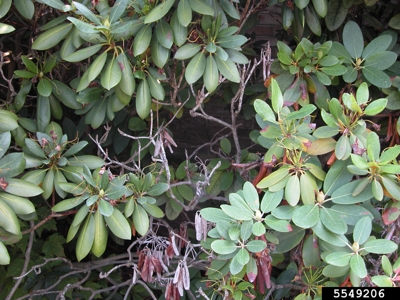A number of pests, pathogens and problems can result in branch dieback in woody plants. Among them are fungi that are described as being opportunistic pathogens. These fungi are usually able to cause disease in host plants only when the plant is weakened or stressed to begin with. Infection typically occurs when a spore germinates in the presence of moisture on the plant surface and a thread-like fungal structure penetrates via openings such as wounds or lenticels (pore-like structures in bark). Wounds can be from mowers and trimmers, pruning, breakage, or animal damage (insects/birds/mammals).
Fungi often associated with cankers and dieback include Botryosphaeria, Nectria and Phomopsis. Other causes of dieback include environmental stresses such as winter injury, drought, and salt damage, wood-boring insects, vascular wilt diseases, and herbicide injury. Soil compaction, excavation that damages the roots, vole damage to roots and root disease can also result in dieback of branches or entire plants.
Symptoms
Symptoms caused by canker and dieback fungi include wilting, yellowing, and browning of leaves, defoliation, dark and sunken areas (cankers) on stems and branches, loose bark, browning of wood within dying branches, and branch dieback. Symptoms may occur on one or more sides or areas of the plant. When dieback is noted, look for and think about what stress factors may be currently present but also those that may have occurred in the past year or more. When a fungus infects a woody stem or branch, it can take weeks, months, or more for symptoms to appear. Factors to consider for newly planted trees and shrubs include planting depth (generally too deep), lack of watering during the first season or two, suitability of the plant for the site (sun exposure, hardiness zone), and possibly other pest or disease problems.
For well-established plants that have seemed healthy for years and then begin to die back, consider severe winter weather, drought stress over the last season or two, wounds, or other pest or disease problems. For example, a rhododendron sample submitted to the UConn Plant Diagnostic Lab illustrated the relationship between stress and fungal dieback. The fungus Botryosphaeria was associated with the problem but there was also a high population of azalea bark scale insects which would have not only reduced plant vigor due to feeding on sap but also created numerous feeding wounds on the branches. These rhododendrons were also in a location that resulted in competition for water with a dogwood tree and possibly exposure to hot afternoon sun. Extended periods of dry weather during summer and early fall or severe winters may come into play.

Penn State Department of Plant Pathology & Environmental Microbiology Archives,
Penn State University, Bugwood.org
Management Practices
Management practices include proper plant selection, sanitation and pruning, and good cultural practices to maintain plant health. When selecting trees and shrubs for the landscape, always choose those with a hardiness rating, sun exposure preference, and mature size that match the site. Most ornamental plants do best on a well-drained, fertile soil. Inspect plants before purchase and avoid those with any evidence of weak growth, dead or dying parts or visible pest or disease problems.
When pruning for shaping, size control or promoting plant vigor, always use proper pruning technique and prune when plant surfaces are dry. Most fungal plant pathogens require moisture to produce spores and cause new infections. If dieback is a problem, prune out dead or dying branches and remove them from the site. Disinfect the pruning tool between cuts using 10% household bleach, 70% alcohol, or a disinfectant product. If bleach is used, rinse to prevent rust. A good time to prune is late in the dormant season for many plants. For spring flowering trees and shrubs, wait until after flowering to avoid removing flower buds.
Cultural practices that promote good health in plants are very important in reducing their susceptibility to disease (and some insect pests). The best approach is to fertilize according to a soil test. Soil testing services are available at the UConn Soil Analysis Lab. Water deeply once or twice a week during extended periods of hot, dry weather. Frequent, light watering that only moistens the soil surface is not beneficial. Fungicides are not recommended for control of this problem.
Despite good cultural practices, pests and diseases at times may appear. Chemical control should be used only after all other methods have failed. For pesticide information please call UConn Home and Garden Education Center or your local cooperative extension office.
The UConn Home & Garden Education Center supports UConn Extension’s mission by providing answers you can trust with research-based information and resources. For gardening questions, contact us toll-free at (877) 486-6271, visit our website at homegarden.cahnr.uconn.edu, or reach out to your local UConn Extension center at cahnr.uconn.edu/extension/locations.
UConn Home and Garden Education Center, 2018.